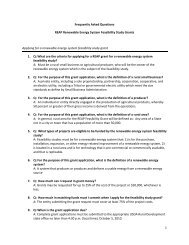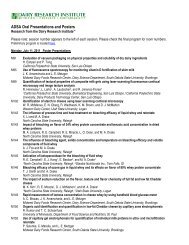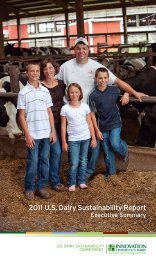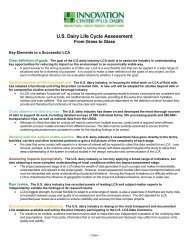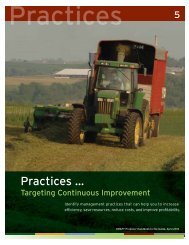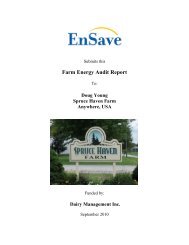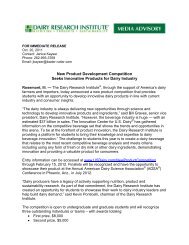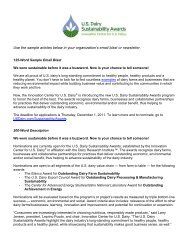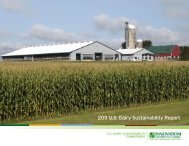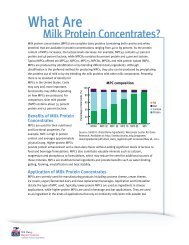Processor Handbook - Innovation Center for US Dairy
Processor Handbook - Innovation Center for US Dairy
Processor Handbook - Innovation Center for US Dairy
You also want an ePaper? Increase the reach of your titles
YUMPU automatically turns print PDFs into web optimized ePapers that Google loves.
Tip 1. Identify targets<br />
A good starting point <strong>for</strong> deciding what to communicate<br />
is to clearly identify the company’s primary audience(s),<br />
and their interest in sustainability and knowledge about<br />
the various sustainability topics. Also, determine the most<br />
effective communication channels to communicate with them.<br />
There are various ways to identify the audience and<br />
determine what and how to communicate. Methods<br />
<strong>for</strong> communicating include: surveys, market reports,<br />
stakeholder meetings and visits, or look at what peers are<br />
doing. Internal research can help. Ask company leaders and<br />
colleagues question like:<br />
• What in<strong>for</strong>mation is most relevant <strong>for</strong> customers or<br />
primary audience targets to know<br />
• What in<strong>for</strong>mation will influence the audience’s<br />
opinion about the company<br />
• If particular in<strong>for</strong>mation is left out, will the<br />
company’s sustainability communications be<br />
perceived as “green washing” (claims or benefits<br />
that may be viewed as exaggerated or not provable)<br />
by contacts or stakeholders<br />
Tip 2. Educate colleagues<br />
Communicating about new topics like sustainability can<br />
be uncom<strong>for</strong>table <strong>for</strong> a company and its management<br />
team members, who may not be as familiar with the issue.<br />
They may need to understand, first, the benefits and value<br />
of communicating about the company’s sustainability<br />
per<strong>for</strong>mance and progress.<br />
• Show examples about what peers are doing.<br />
• Share the in<strong>for</strong>mation gathered about the<br />
audience targets.<br />
• Provide evidence gathered or requests received<br />
from market and stakeholder demands and interests.<br />
• Create a draft of the communication.<br />
This type of communication can bring new value to the<br />
<strong>for</strong>efront and enhance organizational pride – both of which<br />
can be shared with key contacts, stakeholders and investors.<br />
Sustainability communications also shows how the company<br />
contributes to the community and industry, and, most<br />
importantly, is being a responsible corporate citizen.<br />
Tip 3. Clarify scope<br />
If the scope or boundary of the dairy company’s in<strong>for</strong>mation<br />
differs from the scope of the indicators as highlighted<br />
in the Guide, it should explain the difference and reasons<br />
<strong>for</strong> the deviation.<br />
Tip 4. Explain the context<br />
When communicating the in<strong>for</strong>mation about a processor’s<br />
or manufacturer’s sustainability per<strong>for</strong>mance, it is<br />
important to provide readers with contextual in<strong>for</strong>mation<br />
including management strategies, priorities, risks and<br />
opportunities related to the environmental, community and<br />
economic topics in the Guide. The contextual in<strong>for</strong>mation<br />
enables stakeholders and reviewers to understand the dairy<br />
company, its operational systems and the situation in which<br />
it operates more fully.<br />
Tip 5. Compare per<strong>for</strong>mance<br />
<strong>Dairy</strong> companies should establish the baseline or benchmark<br />
year against which it will compare and communicate<br />
progress on an annual base. Companies should<br />
communicate changes in the way it measures sustainability<br />
per<strong>for</strong>mance over the years, or how results and numbers<br />
are influenced by internal or external reasons like mergers,<br />
selling of production units or supply chain issues.<br />
Tip 6. Set expectations<br />
Setting clear expectations is important. Let the audience<br />
know the timeline <strong>for</strong> highlighted in<strong>for</strong>mation (or projects).<br />
• What is the progress, benefits or value made in the<br />
last year, month or different period of time<br />
Tip 7. Ensure credibility<br />
Credibility and the “provability” of the in<strong>for</strong>mation that a<br />
company shares about sustainability are crucial.<br />
• How does the company guarantee that the<br />
in<strong>for</strong>mation is correct, factual and true<br />
• Is the in<strong>for</strong>mation credible when it is<br />
communicated<br />
• Do in<strong>for</strong>mation points support the story<br />
• Has the in<strong>for</strong>mation been cross-checked and<br />
verified by colleagues<br />
If exact numbers are not available at the time, clarity<br />
and accuracy is important. Communicate the facts to the<br />
reader – <strong>for</strong> example, “we are fine-tuning our measurement<br />
system” or “these numbers are estimates.”<br />
Resources<br />
• Visit www.corporateregister.com (see “Integrated<br />
reporting).<br />
• More in<strong>for</strong>mation about the U.S. <strong>Dairy</strong><br />
Sustainability Report and trends in sustainability<br />
reporting can be found at www.<strong>US</strong><strong>Dairy</strong>.com/<br />
Sustainability/Reporting/Pages/Home.aspx.<br />
5<br />
43





